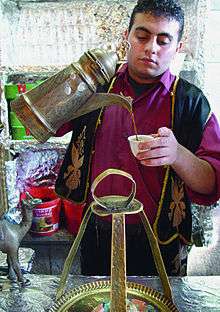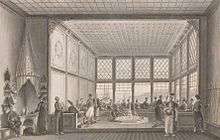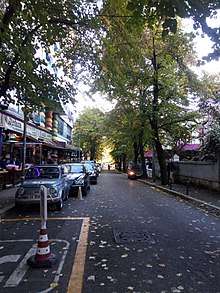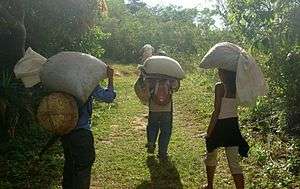Coffee in world cultures
Countries have cultivated coffee beans into various vehicles to satisfy needs unique to each country. Whether it be for energy, socialization, or tradition, the cultivation of coffee has served as a motivating force of the world. The modernization of coffee and its unique forms across cultures are markers of tradition and modern changes across continents. Coffee culture appears in the way in which people consume coffee, the way they make it, and where coffee is served and shared. Each of these factors combined reflects the lives of the people in these countries and the importance of coffee across the world.
History
Origins

Ethiopian Legend
The heritage of coffee grown all around the world can be found in the forests of Ethiopia, where the theory of its origins also resides. According to local legend, a goat herder named Kaldi saw his goats eating coffee "berries". This caused them to gain extreme amounts of energy, preventing them from sleeping at night. He brought this information to local monks, who created a drink with the coffee beans. One monk who drank the concoction found that it allowed him to stay up all night and pray. As this information spread to other Ethiopian monks, it began to spread across the civilized world.[1]
Cultivation
Much of the popularization of coffee is due to its cultivation in the Arab world, beginning in what is now Yemen, by Sufi monks in the 15th century.[2] Through thousands of Muslims pilgrimaging to Mecca, the enjoyment and harvesting of coffee, or the "wine of Araby" spread to other countries (e.g. Turkey, Egypt, Syria) and eventually to a majority of the world through the 16th century. Coffee, in addition to being essential in the home, became a major part of social life.[3] Coffeehouses, qahwa قَهوة in Modern Standard Arabic, became "Schools of the Wise" as they developed into places of intellectual discussion, in addition to centers of relaxation and comradery.[1]
Expansion[1]
Europe
By the 17th century, European travelers had brought coffee to the continent, where large amounts of controversy surrounded it as its popularity grew. The "Schools of the Wise" of the Arab world began spreading across the continent, becoming known as "penny universities" in England, and developed to satisfy the needs of various social classes. In addition, coffee replaced beer and wine as the "breakfast drink", improving the quality produced by the working classes. Once Pope Clement VIII gave a papal pardon to coffee in 1615,[2] it increased the coffee consuming population and contributed to its eventual expansion to the Americas.[1]
The Americas
Traders, conquistadors, and missionaries brought coffee over to the Americas with them during the Columbian Exchange. In terms of North America, the British brought coffee over to New York, then New Amsterdam, in the 1600s. It reached peak popularity after the Boston Tea Party, and has remained an American staple drink ever since. The parent seed of the Arabica coffee found mainly in the Caribbean, but also in other countries in South and Central America, was brought over in 1723. After the Mayor of Amsterdam gifted King Louis XIV a coffee plant in 1714, naval officer Gabriel de Clieu stole a seed and brought it to the island of Martinique. Its cultivation eventually spread across the aforementioned regions. Brazil, today's largest producer of coffee, was brought coffee by Francisco de Mello Palheta, who got the seeds from French Guinea.[1]
Slavery
Today's high-grossing industry of coffee was built by the institution of slavery across the world. Once the demand for coffee grew past the amount being produced in the Arabic world, the Dutch began cultivating coffee in Indonesia, modern-day Java, and eventually moved to Sumatra and Celebes in the 17th century. Much of the coffee grown in Africa and the Americas was grown and harvested by slaves as well.[4]
World cultures
Coffeehouse culture

Coffeehouse culture began in the Arab world, and eventually spread to other areas of the world and blended with the local culture. Traditional Arab coffeehouses a places where mostly men meet to socialize over games, coffee, and water pipes (shiisha or agriile). Depending on where the coffeehouse is, its specialty differs. In North Africa, green tea is served with mint or coffee is served European style. Arabic coffee, or Turkish coffee, is made in Egypt and the Levant countries. Arabic coffee is a very small amount of dark coffee boiled in a pot and presented in a demitasse cup. Particularly in Egypt, coffee is served maZbuuT, which means the amount of sugar will be "just right", about one teaspoon per cup. However, in the Arabian Peninsula, Arabic coffee is roasted in such a way that the coffee is almost clear; it is traditional for the host to refill the guest's cup until politely signaled that the guest is finished.[3]

Coffeehouses have gained popularity in other countries as well. Turkey, for example, shares many similarities to Arabic coffeehouses as they integrated into the culture during the Ottoman Empire's reign. On the other hand, Austria's popular Viennese coffeehouses were created with Europe's introduction to coffee. These coffeehouses are dissimilar in that they are not usually places of gathering, instead many people go to sit alone and enjoy coffee.[5] Other variations have been created as the world has modernized: coffeeshops in North America and the Philippines, kopi tiam in Malaysia and Singapore, and cafes in various other countries.[4]
Africa
Despite originating and 13% of the world's coffee supply being grown in various African countries, coffee culture has just recently emerged. The most explicit sense of a coffee culture is in Northern Africa and Ethiopia. Those who are attempting to create a larger coffee consumption industry in Africa are looking to make it completely dependent on coffee grown in Africa.[6]
Ethiopia
Drinking Ethiopian coffee, especially in the place of coffee's origin, is a cultural experience. The process for making the coffee, known as Bunna, takes over an hour. First the beans are washed in water, and then placed into a skillet over a fire. Once the beans have burst from their skins, they are ground with a metal stick. The grounds are placed into a jebena, an Ethiopian pot, with hot water and served in a cini cup.[7][8]
Europe
The countries of Europe have developed various versions of coffee that have spread across the world. Café au lait and espressos have become norms across in various coffee shops, while the coffee grown in countries formerly colonized by European powers have in turn affected European coffee culture.
France
French coffee, such as café au lait, has spread across and become popular across the world. However, the method of consuming remains uniquely French. Coffee is drunk sitting down in cafes or relaxing areas. It is also consumed in small amounts, and not for taste or energy. Coffee has been engrained into everyday French culture.[7]
Greece
Greece has a surprisingly strong and present coffee culture. There are two main places where coffee is consumed: the kafeteria and the kafenio. The kafeteria, which changes from cafe to bar at night, is mainly for young people under 35 years old to meet and hang out. The kafeneio is where all the old gentlemen used to meet during the popularity "Schools of the Wise". The popular drink of the kafeneio is the ellinikós kafés, which is very similar to Turkish coffee. Its grains are also used for fortune telling after the person finishes drinking. However, frappes have become more popular among the young in kafeterias.[9] The Greek frappe is a mix of Nescafé, milk, and sugar frothed up and poured over ice.[8][9]
Albania

In 2016, Albania surpassed Spain by becoming the country with the most coffee houses per capita in the world.[10] In fact, there are 654 coffee houses per 100,000 inhabitants in Albania, a country with only 2.5 million inhabitants. This is due to coffee houses closing down in Spain due to the economic crisis, and the fact that as many cafes open as they close in Albania. In addition, the fact that it was one of the easiest ways to make a living after the fall of communism in Albania, together with the country’s Ottoman legacy further reinforce the strong dominance of coffee culture in Albania.
Ireland
Although tea is by far the most popular drink in Ireland, the country has a long history of coffeehouses and its coffee culture has created a drink that has gained worldwide popularity. Irish coffee is a blend of hot coffee, whiskey, and whipped cream. It is usually served after dinner in many Irish establishments.[8]
Italy

As the birthplace of the espresso machine, Italy equates coffee to espresso. You can pick one up at a Neapolitan bar or any nameless cafe in the countryside. One may get their espressos suited to their tastes[7][8]. The most popular coffee-based beverages are:
- Caffè (espresso)
- Caffè macchiato: espresso with a little amount of milk or milk foam
- Caffè corretto: espresso with a little amount of an alcoholic beverage, as Brandy, Sambuca, Grappa, Cognac
- Caffellatte (or caffè latte): coffee and milk, usually in a 1:1 proportion
- Latte macchiato: coffee and milk, usually in a 1:2 or 1:3 proportion
- Caffè americano: an espresso with more water
Nordic Countries
The well-known coffee-break was created in the Nordic region, particularly Sweden and Finland. The fika (pause) tradition calls for two breaks around 10 a.m. and 3 p.m. during the work day, and is enforced through the law. A very social event, fika is usually a coming-together of loved ones, friends, and colleagues over strong coffee and a shared sweet.[11]
Portugal
In the past, Portugal imported most of its coffee beans from Brazil, which heavily influenced its coffee culture. Using mainly robusta beans, Portuguese coffee is made very strong, and the usual order is a Bica (only in Lisbon), a very bitter shot of espresso. According to a legend, this is an acronym for "Beba Isso Com Açúcar", which translates to "drink this with sugar". Much like Nordic cultures. coffee in Portugal is used for shared time among friends.[7]
Spain
Coffee is a way of life in Spain. It is consumed during almost every meal, but most often during the almuerzo, a small meal in the middle of the day, and after the cena or dinner. The various staples of the coffee life are:[12]
- Café Solo: espresso
- Café Cortado: espresso with a small amount of milk
- Café con Hielo: iced espresso
- Café Americano: Café Solo with more water
- Café Caramel/ Café Bonbon: espresso/ Café Solo with condensed milk
- Café Doble: double espresso
- Café con Leche: coffee with milk
- Carajillo: espresso with a small amount of rum, brandy, or whiskey
- Trifasico (Catalan): Carajillo with milk
- Café Sombra/ Café Manchada: a glass of milk with a small amount of coffee
- Café Suizo: coffee with whipped cream
Yugoslavia
Latin America

Latin America is defined as the territories and countries in the Americas whose main languages are Romantic. A majority of the top-producing coffee countries are in this region, and small, family-owned coffee businesses are still fairly successful. Coffee, especially with the combination of European and indigenous cultures, is extremely popular and unique to each region.
Mexico
The most popular form of coffee in Mexico is café de olla. Its name derives from how the coffee is made in a clay pot. Traditionally, piloncillo, unrefined brown sugar, and a cinnamon stick is served with the dark roast coffee made in the pot.[7]
Brazil
Coffee's extreme popularity in Brazil reaches all ages and demographics. One of the most popular drinks of the country is café com leite, which is extreme strong coffee blended with a large amount of milk. This drink is usually served at breakfast to adults and children alike. Another popular Brazilian drink is the cafezhino, made with a strong coffee blend similar to that used in café com leite and a large portion of sugar.[7]
Ecuador
Coffee in Ecuador is often pre-sweetened and made using instant coffee. When one orders a café con leche, they receive a large glass of steamed milk with a small pile of instant coffee. In order to request coffee made in the traditional sense, the correct way to order is to request a café filtrado.[8]
Cuba
Much like in Brazil, coffee is best enjoyed within the family in Cuba. Cuban coffee is usually a coffee ration mixed with a store-bought coffee blend, is accessible. It is usually made very strong, but sweet. One popular form is the café cubano, or the cafecito, which is an espresso made with sugar. A less sweet version is the coradito, an espresso with steamed milk.[7]
North America
Although Canada consumes more coffee than the United States, the populations of both countries enjoy quick, fast, and sugary consumptions of coffee. Both are dominated by coffee chains (e.g. Tim Horton's and Starbucks), yet have different coffee cultures from region to region. For example, the Northeastern U.S. mostly wants fast coffee (e.g. Dunkin Donuts "Everybody runs on Dunkin" slogan). While places like Portland, OR and San Francisco, CA have developed a more hipster-esque style café-roaster coffee culture.[13]
East Asia
Coffee culture is a relatively new, yet large phenomenon in East Asia. Coffee shops, both Starbucks and smaller businesses, have been growing exponentially in urban areas. The most popular coffee shops are those in which tradition has blended with the new surge of coffee culture.[14]
Japan
Japanese coffee culture has been able to blend that of North American coffee culture and Japanese tea culture.[7] While the country does have its fast coffee pickups in the major cities, it is also developing coffee shops similar to those of traditional tea shops. These coffee shops are very trendy, with latte designs and popular Japanese culture; however, they also try to preserve the politeness and methods of old Japanese tea serving.[15]
Korea
Southeast Asian Coffee Culture
Kopitiam is a traditional Southeast Asian coffeehouse, and is most popular in Singapore and Malaysia. All generations hang out at kopitiams, while drinking strong green tea and coffee with milk in their traditional forms. While these exist in almost every neighborhood, more modern versions of coffee are spreading across major cities and coffee centers. While urban areas have adopted the trend of nano- and micro-roasters, coffee growing cities (e.g. Bangkok and Jakarta) have created their own speciality blends that are sold in local speciality coffee shops.[14]
Vietnam
.jpg)
As the French brought coffee to Vietnam, it bears its influence heavily. Similarly, coffee is a large part of both cultures. For example, the Vietnamese take their coffee very seriously, only importing the best roasts and blends. However, when referring to Vietnamese coffee, words like "success" and "discover" are used.[16] The most popular coffee drink in Vietnam is ca phe sua da, or "coffee, milk, ice". This drink is created by mixing strong coffee poured through a water drip and sweetened condensed milk, and then pouring that over ice.[7][8]
References
- 1 2 3 4 5 "The History Of Coffee". ncausa.org. National Coffee Association of the U.S.A. October 24, 2016.
- 1 2 Civitello, Linda (2007). Cuisine and Culture: A History of Food and People. Hoboken, NJ: John Wiley. ISBN 9780471741725.
- 1 2 Brustad, Kristen; Al-Batal, Mahmoud; Al-Tonsi, Abbas (2010). Alif Baa: Introduction to Arabic Letters and Sounds. Georgetown University Press. p. 132. ISBN 9781589016330.
- 1 2 Tucker, Catherine (2011). Coffee Cultures: Local Experiences, Global Connections. New York: Routledge. pp. 35–43. ISBN 9780415800242.
- ↑ Hoeller, Sophie-Claire (October 17, 2015). "Here's why Coffee is Such an Important Part of the Culture in Vienna". Coffee Culture in Vienna. Business Insider.
- ↑ Spooner, Samantha (January 11, 2015). "Think Africa's Coffee Culture is Something New? Ethiopia's been Showing Us How it's Done for Centuries". Mail and Guardian Africa. Mail and Guardian Africa.
- 1 2 3 4 5 6 7 8 9 "Coffee Countries: How a Cup of Joe is Enjoyed Around the World?". huffingtonpost.ca. The Huffington Post. October 24, 2016.
- 1 2 3 4 5 6 Bland, Alastair (March 15, 2013). "Coffee Here, and Coffee There: How Different People Serve the World's Favorite Hot Drink". www.smithsonianmag.com. Smithsonian Institution.
- 1 2 Trivolis, Despina (February 19, 2013). "Greek Coffee in Athens". Culinary Backstreets. Culinary Backstreets, Inc.
- ↑ http://www.ocnal.com/2018/02/albania-ranked-first-in-world-for.html
- ↑ Spiegel, Alison (April 10, 2015). "What We Could All Learn from Sweden's Coffee Break Ritual". Huffington Post. TheHuffingtonPost.com, Inc.
- ↑ "Spanish Coffee". Spain Made Simple. Spain Made Simple. 2016.
- ↑ Strand, Olivia (February 10, 2012). "In Portland, Ore., a D.I.Y Coffee Culture". NY Times. The New York Times Company.
- 1 2 Serna, Bronwen (April 27, 2016). "The Blossoming Coffee Culture of Southeast Asia". The Specialty Coffee Chronicle. Specialty Coffee Association of America.
- ↑ Beser, Ari (September 11, 2015). "The Way of Coffee: Japan Brews Up Its Own Unique Culture". National Geographic. The National Geographic.
- ↑ Graydon, Nicola (October 6, 2014). "Vietnam: Ho Chi Minh City's Coffee Culture". The Telegraph. Telegraph Media Group Limited.
